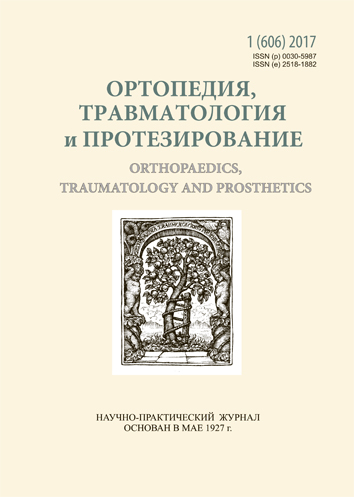Restorative treatment of victims with multiple gunshot fractures of long bones
DOI:
https://doi.org/10.15674/0030-59872017146-53Keywords:
multiple gunshot fractures of long bones, system of re¬storative fracture treatment, replacement of fixation method, individual program of medical rehabilitationAbstract
Due to the large number of victims of the armed conflict in the east of Ukraine with multiple long-bones gunshot fractures, there was a need for comprehensive and step-by-step restorative treatment at all levels of medical evacuation, especially at III and IV.
Objective: to develop a step-by-step system for the rehabilitation of victims with multiple long-bone fractures and to prove its effectiveness in preventing the most common complications.
Methods: 380 patients were divided into three groups: the developed system and individual programs of medical rehabilitation were used in the main (119 people), in I (118) — modern conventional methods of treatment, in II (143 wounded in Afghanistan) — methods, used in the 80th of the twentieth century, with effective rehabilitation. To assess the results of treatment, the Luboszyce-Mattisa-Schwarzberg scale was chosen in the modification of Shevtsov.
Results: a rehabilitative treatment system was developed, including a reasoned replacement of the fixation method (biochemical and clinical blood tests, evaluation of the limb state), an algorithm for surgical treatment using modern medical techniques (VAC- therapy, ultrasound cavitation, Vivostat® PRF) and IDEP. The best long-term results (1.2–1.5 years) were obtained in patients of the main group compared with I and II. The risk of contamination of the operating wound in the patients of the main group decreased by 5.8 %, the occurrence of osteomyelitis by 4.2 %, the incidence of neurologic deficits by 2.4 %, vascular disorders by 7.3 %, the development of false joints by 2.8 %, contractures — by 11.3 %.
Conclusions: the proposed system of restorative treatment of multiple long-bone fractures is effective in preventing the most common complications.References
- Ankin LN, Ankin NL. Delayed internal osteosynthesis in the treatment of gunshot fractures. Orthopaedics, Traumatology and Prosthetics. 2012;(2):114-8. doi: 10.15674/0030-598720122114-118. (in Russian)
- Gayko GV. Intramedullary blocking osteosynthesis in the treatment of patients with closed fractures of long bones. Visnyk ortopedii, traumatologii i protezuvannya. 2007;(1):26-33. (in Russian)
- Gayko GV, Kalashnikov AV, Malik VD. Treatment of patients with diaphyseal fractures of the tibia using blocking intramedullary osteosynthesis. Trauma. 2011;12(1): 6-8. (in Ukrainian)
- Klimovitsky VG, Antonov AA, Grebenyuk AM. Rehabilitation in the early postoperative period with intramedullary blocked hip osteosynthesis. Trauma. 2009;10(1):9-13. (in Russian)
- Korol SO, Bespalenko AA. Using modern methods of specialized traumatological treatment of injured with gunshot fractures of the long bones (IV level of health care). Litopys ortopedii ta travmatologii. 2015;1-2(31-32):28. (in Ukrainian)
- Dazhin AY. Medical rehabilitation of patients with diaphyseal fractures of the forearm bones based on the surgical technologies. Medical Bulletin of Bashkortostan. 2012;2:157-161. (in Russian)
- Cameron ID. Coordinated multidisciplinary rehabilitation after hip fracture. Disabil Rehabil. 2005;27(18–19):1081–90. doi: 10.1080/09638280500061261.
- Tejan J, Lindsey RW. Management of civilian gunshot injuries of the femur. A review of the literature. Injury. 1998;29(1):SA18–22.
- Brien WW, Kuschner SH, Brien EW, Wiss DA. The management of gunshot wounds to the femur. Orthop Clin North Am. 1995;26(1):133–8.
Downloads
How to Cite
Issue
Section
License
Copyright (c) 2017 Oleksandr Buryanov, Anatoliy Kazmirchuk, Yuriy Yarmolyuk, Myroslav Vakulych, Dmytro Drychyk

This work is licensed under a Creative Commons Attribution 4.0 International License.
The authors retain the right of authorship of their manuscript and pass the journal the right of the first publication of this article, which automatically become available from the date of publication under the terms of Creative Commons Attribution License, which allows others to freely distribute the published manuscript with mandatory linking to authors of the original research and the first publication of this one in this journal.
Authors have the right to enter into a separate supplemental agreement on the additional non-exclusive distribution of manuscript in the form in which it was published by the journal (i.e. to put work in electronic storage of an institution or publish as a part of the book) while maintaining the reference to the first publication of the manuscript in this journal.
The editorial policy of the journal allows authors and encourages manuscript accommodation online (i.e. in storage of an institution or on the personal websites) as before submission of the manuscript to the editorial office, and during its editorial processing because it contributes to productive scientific discussion and positively affects the efficiency and dynamics of the published manuscript citation (see The Effect of Open Access).














